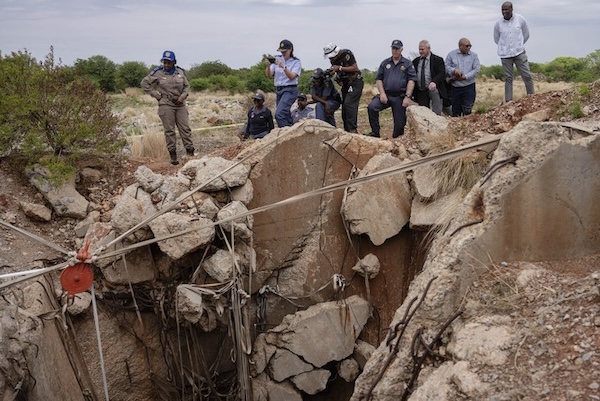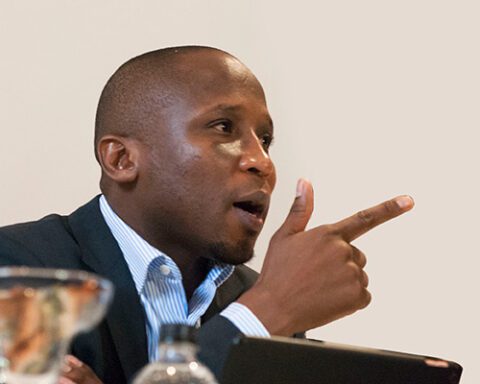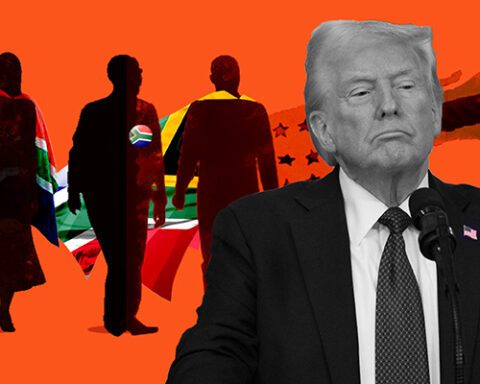Think zama zamas are someone else’s problem? A notional issue afflicting far-flung towns of little consequence? Think again. They’re here in Joburg – and they’re right under your feet.
At least, if you’re around the south of Roodepoort, Main Reef Road or in Selby, that is. City Press last weekend detailed how roads and factory floors have apparently been swallowed by sinkholes as illegal miners tunnel too close to the surface in their search for scraps of gold.
One business owner told the publication of actually hearing the miners beneath his factory and the road; another of seeing rudimentary mining equipment in a gaping hole where he’d been standing just moments before.
The city, of course, has done nothing about the damage. No budget. Of course.
But if that’s a failure of the state writ small, the broader issue of illegal mining speaks to multiple failures on the part of the national authorities. And not just the parlous state of the economy, which has sucked people into this world of rampant criminality – of gangs, drugs, violence, intimidation, corruption, human trafficking, smuggling. And, underlying it all, the most base exploitation of poverty.
It is this criminality that makes the state’s failure most apparent, Joburg Indaba chair and former mining exec Bernard Swanepoel tells Currency. It speaks to the inability of the security services to enforce the law, and of crime intelligence to break the chains of criminality that tie the pawns in the tunnels to the kingpins who sell gold on world markets.
Complicating matters is the lacuna that exists in the law: there is no criminal sanction for illegal mining per se. Unless they’re actually found in possession of gold, zama zamas who are picked up by the police face petty charges, like trespassing. That’s an admission of guilt fine; a slap on the wrist and straight back to it.
The problem, Swanepoel believes, is that the authorities never imagined the scale of the problem. “The legislation hasn’t caught up to the reality,” he says.
That reality is no joke; precise numbers are hard to come by, but the Institute of Security Studies in 2019 estimated that there were about 30,000 zama zamas in South Africa. With the runup in the gold price – at $2,653 an ounce, it has gained over 30% over the past year – illicit activity is likely to have ramped up.
Consider that in Stilfontein alone, more than 1,300 illegal miners reportedly surfaced after the police implemented Operation Vala Umgodi, which saw the authorities blocking the miners’ supply lines so they’d have no choice but to exit. And hundreds more are thought to still be below ground, stuck in an abandoned shaft that extends 2km into the earth.
With their supply lines cut, they’re short of food, water and, presumably, batteries for their headlights. While the government wants to “smoke them out” – a deeply unfortunate turn of phrase – NGOs are supplying them with humanitarian aid following a court order. But pulling the zama zamas out of the mine will involve an operation thought to cost R1m a day. And no-one seems keen to foot that bill.
Kicking the can down the road
You can’t blame the company that once owned the mine. As Swanepoel points out, pictures of the rescue site suggest the shafts were once properly sealed with concrete slabs.
It’s one of the things that South Africa has got right, he adds: the legislation around mine closure. From the time ground is broken, mining companies have to make financial provision for rehabilitation. These funds are ringfenced, set aside for the sole purpose of rehabilitation of land to its former state, and the closure of tailings, surface infrastructure and underground operations. Should a mine fail in its rehabilitation efforts or go bust, those funds can be accessed by the department of mineral and petroleum resources (DMPR) and used for that purpose.
Once the mine is fully rehabilitated, the department is supposed to issue a closure certificate, and responsibility for that mine then falls to the government. Supposed to.
The reality is that during Swanepoel’s time, this seldom happened. “It was almost like the state was just not prepared to accept that final responsibility and issue a closure certificate,” he says.
Currency understands that little has changed. The issue, apparently, is that the department isn’t keen to take on financial liability for the mines. After all, it’s already responsible for more than 6,000 derelict and ownerless mines; why add to the list?
Now, not all mines are closed up as they should be. Vuyisile Ncube, from Human Rights Watch’s environmental and human rights division, in 2022 told African Business that some companies have simply disappeared into the night when mines are no longer profitable, which means the closure processes aren’t triggered with the DMPR. As she tells it, weak compliance monitoring and enforcement by the department doesn’t help.
But when mining companies do properly close down their operations, they struggle to walk away; the mine remains their asset until they get that magical closure certificate.
Where that leaves responsibility for situations like Stilfontein is unclear. But you surely cannot hold to account a company that has followed the legislation to the letter, when the department has moved with the speed of a recalcitrant glacier.
No quick fix
The central issue, as mining sources make clear, is that this isn’t a mining industry problem; it’s primarily a criminal problem. As Swanepoel is quick to point out, blaming the formal mining sector for zama zamas is a bit like blaming banks for ATM bombers.
It means that the solutions lie elsewhere.
The most obvious are systemic: fix the economy; fix the police; fix crime intelligence.
None of those look likely to happen any time soon. Certainly, tepid economic growth won’t be sufficient to kickstart the kind of employment that’s needed to undercut the lure of illegal mining.
Crime intelligence has hardly covered itself in glory (remember the July 2021 riots?). And the security services more broadly seem to be preoccupied with the expendable foot soldiers in the tunnels; those deriving real benefit from the illicit enterprise – those at the very top of the criminal pyramid – continue to act with impunity.
More immediately, the government could improve the law. For starters, there’s the option of attaching sanction to illegal mining; real penalties may act as a deterrent. But there’s also the need to create a legal artisanal mining sector. This isn’t an earth-shattering proposal; the DMPR has already drawn up an artisanal mining policy – only, it’s apparently dragging its feet (shock, horror) in putting all the pieces in place. It’s simply not moving fast enough to create a legal avenue for communities to be involved in the mining sector.
Another idea apparently being mooted by the mining sector is to rethink what mine rehabilitation looks like. Rather than demolish the surface infrastructure on the mines and return the land to its natural state, the thinking is to retain the buildings for communities to use for workshops, accommodation or industry, small business and the like – to repurpose the assets to create value. This isn’t just about better – more sensible – land use; it’s also about eliminating the criminal element by creating a sustainable environment for communities.
Of course, you can’t say the state is making no effort; Operation Vala Umgodi is one attempt to break the chain. But combating illegal mining is something of a Sisyphean task. As one shaft is closed, another is blasted open.
Without fixing the systemic issues that underpin illegal mining, and which allow such criminality to flourish, the battle will be lost.
A mine in Stilfontein, in the North West, used by zama zamas. Picture: Ihsaan Haffejee/GroundUp (CC BY-ND 4.0).
Sign up to Currency’s weekly newsletters to receive your own bulletin of weekday news and weekend treats. Register here.










